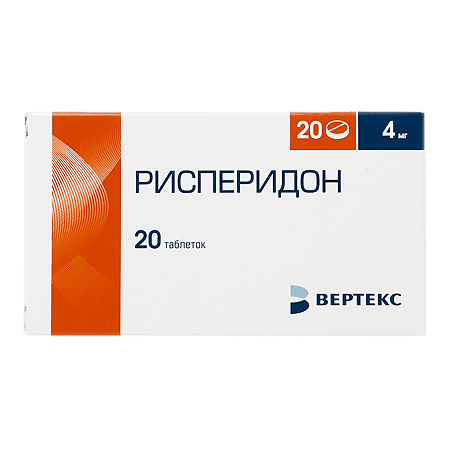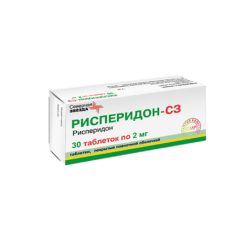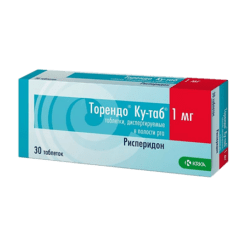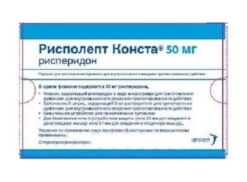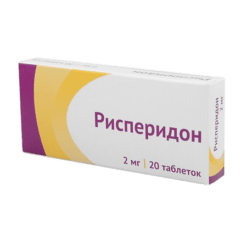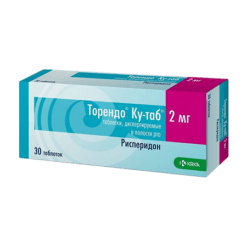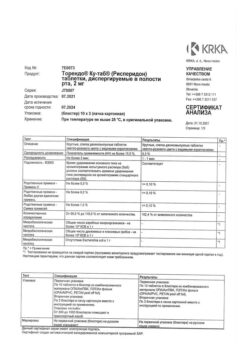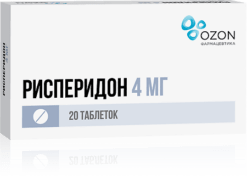No products in the cart.
Risperidone, 4 mg 20 pcs
€1.00
Out of stock
(E-mail when Stock is available)
Description
– treatment of schizophrenia in adults and children aged 13 to 17 years;
treatment of manic episodes associated with bipolar disorder of moderate to severe severity in adults and children aged 10 years and older;
– Short-term (up to 6 weeks) treatment of persistent aggression in patients with moderate to severe dementia due to Alzheimer’s disease who cannot respond to non-pharmacological interventions, and when there is a risk of self-harm and/or harm to others;
The short-term (up to 6 weeks) symptomatic treatment of persistent aggression in a behavioral disorder in children 5 years and older with mental retardation diagnosed according to DSM-IV, in which, because of the severity of aggression or other disruptive behavior, medication therapy is required. Pharmacotherapy should be part of a broader treatment program, including psychological and educational interventions. Risperidone should be prescribed by a specialist in child neurology and child psychiatry or by a physician familiar with the treatment of conduct disorders in children and adolescents.
Active ingredient
Active ingredient
Composition
Composition
active ingredient:
risperidone – 4,000 mg;
excipients:
Lactose monohydrate – 290,000 mg;
Microcrystalline cellulose – 80,000 mg;
Corn starch – 20,000 mg;
colloidal silica – 2,000 mg;
magnesium stearate – 4,000 mg;
film shell:
[hypromellose – 7,200 mg, talc – 2,400 mg, titanium dioxide – 1,320 mg, macrogol 4000 (polyethylene glycol 4000) – 1,080 mg] or [dry film coating mixture containing hypromellose (60%), talc (20%), titanium dioxide (11%), macrogol 4000 (polyethylene glycol 4000) (9%)] – 12,000 mg.
How to take, the dosage
How to take, the dosage
Ingestion, regardless of meals.
Schizophrenia
Adults
The starting dose of risperidone for all patients (acute and chronic) is 2 mg daily (one or two doses). On the second day, the dose may be increased to 4 mg per day; thereafter, if necessary, the dose may be increased or decreased in 1-2 mg doses at weekly intervals. Usually the optimal dose is 4-6 mg per day. In some cases, a slower dose increase and lower starting and maintenance doses may be warranted.
Doses above 10 mg daily have not been shown to be more effective than lower doses and may cause extrapyramidal symptoms. Because the safety of doses above 16 mg daily has not been studied, doses above this level should not be used.
Benzodiazepines may be added to risperidone therapy if additional sedation is required.
Elderly patients
The recommended starting dose is 0.5 mg twice daily. The dosage can be gradually increased to 1-2 mg per dose twice daily.
Perhaps 13 years of age or older
The recommended starting dose is 0.5 mg once daily in the morning or evening. If necessary, the dose may be increased after at least 24 hours by 0.5 to 1 mg daily to the recommended dose of 3 mg daily with good tolerability. Although efficacy has been demonstrated in the treatment of schizophrenia in adolescents at doses of 1-6 mg daily, no additional efficacy has been observed at doses above 3 mg daily, and higher doses have caused more side effects. The use of doses higher than 6 mg daily has not been studied.
Patients who have persistent somnolence are advised to take half of the daily dose twice daily.
Mania in bipolar disorder
Adults
The starting dose of risperidone for all patients (acute and chronic) is 2-3 mg daily (one or two doses). A dose adjustment should be made no earlier than 24 hours later by 1 mg per day. Usually the optimal dose varies from
1 mg to 6 mg per day. The use of risperidone at a daily dose greater than 6 mg in the treatment of mania in bipolar disorders has not been studied. Prolonged symptomatic treatment with risperidone should be justified.
Elderly patients
The recommended starting dose is 0.5 mg twice daily. The dosage can be gradually increased to 1-2 mg per dose twice daily.
Perhaps 10 years of age or older
The recommended starting dose is 0.5 mg once daily in the morning or evening. If necessary, the dose may be increased after at least 24 hours by 0.5-1 mg daily to the recommended dose of 1-2.5 mg daily with good tolerability. Although efficacy has been demonstrated in the treatment of manic episodes associated with bipolar disorder in children at doses of 0.5-6 mg daily, no additional efficacy has been observed at doses above 2.5 mg daily, and higher doses have caused more side effects. The use of doses higher than 6 mg daily has not been studied.
Patients who have persistent somnolence are advised to take half of the daily dose twice daily.
Behavioral Disorders in Patients with Alzheimer’s Dementia
The recommended starting dose is 0.25 mg twice daily. If necessary, it is possible to increase the dose by 0.25 mg twice a day no more often than every other day. For most patients, the optimal dose is 0.5 mg twice daily. In some patients, however, the effective dose may be 1 mg twice daily.
The drug risperidone should not be used for more than 6 weeks in patients with persistent aggression in Alzheimer’s dementia. During treatment with risperidone, frequent and regular evaluation of the patient is necessary to decide whether continuation of treatment is necessary.
Behavioral disorders
Children and adolescents aged 5 to 18 years
Patients with a body weight of 50 kg or more – the recommended starting dose of the drug is 0.5 mg once daily. If necessary, this dose may be increased by 0.5 mg per day no more frequently than every other day. For most patients, the optimal dose is 1 mg once daily. However, some patients prefer to take 0.5 mg daily, while other patients need to increase the dose to 1.5 mg daily.
Patients weighing less than 50 kg have a recommended starting dose of 0.25 mg once daily. If necessary, this dose may be increased by 0.25 mg per day no more frequently than every other day. For most patients, the optimal dose is 0.5 mg once daily. However, some patients prefer 0.25 mg once daily, while others require increasing the dose to 0.75 mg once daily.
At the time of treatment with risperidone, frequent and regular assessment of the patient is necessary to decide whether continuation of treatment is necessary.
Long-term use of risperidone in adolescents should be under the constant supervision of a physician.
The use in children younger than 5 years has not been studied.
The use in patients with renal and/or hepatic impairment.
In patients with renal insufficiency, excretion of active antipsychotic fraction is delayed. In hepatic insufficiency the concentration of risperidone metabolites in blood plasma is increased. Therefore, in patients with renal and/or hepatic insufficiency, the initial and effective doses are recommended to be reduced by 50%, the dose should be increased more slowly. Risperidone should be administered with caution in this category of patients.
In renal failure (creatinine clearance less than 30 ml/min) or hepatic failure (10-15 points on the Child-Pugh scale), the initial dose of risperidone should not exceed 0.5 mg twice daily. If necessary, the dose may be increased by 0.5 mg when used twice daily. For doses of 1.5 mg or more, twice daily, the interval should be increased to 1 week or longer.
Transition to risperidone treatment
A gradual withdrawal of a previously taken neuroleptic is recommended. If a parenteral neuroleptic depot was previously used, the first dose of risperidone should be taken instead of an injection according to the neuroleptic depot administration regimen.
The abrupt withdrawal of risperidone may result in “withdrawal” syndrome (including nausea, insomnia, increased sweating), so it is recommended that the drug be stopped gradually.
Interaction
Interaction
Caution should be exercised when co-administering Risperidone with drugs that prolong the QT interval, such as antiarrhythmic drugs
Class Ia (e.g., quinidine, procainamide, disopyramide), Class III (e.g., amiodarone, sotalol), tricyclic antidepressants (e.g., maprotiline), some antihistamines, other antipsychotic drugs, some antimalarials (e.g., mefloquine).
Cimetidine and ranitidine increase the bioavailability of risperidone, but have minimal effect on the concentration of the active antipsychotic fraction.
Risperidone decreases the efficacy of levodopa and other dopamine agonists. If concomitant use is necessary, it is recommended to use the lowest effective doses of the drugs.
Hypotensive drugs increase the severity of the decrease in blood pressure with risperidone.
Carbamazepine and other inducers of “hepatic” enzymes (e.g., rifampicin, phenytoin, phenobarbital) reduce the concentration of the active fraction of risperidone in plasma. When prescribed and after withdrawal of carbamazepine, the dose of Risperidone should be adjusted.
Concomitant administration of fluoxetine/paroxetine decreases plasma concentrations of risperidone, but antipsychotic fraction levels increase slightly. It is expected that other CYP2D6 inhibitors, such as quinidine, may decrease the plasma concentration of risperidone.
Verapamil (CYP3A4 and P-glycoprotein inhibitor) increases the plasma concentration of risperidone.
Particularly since risperidone primarily affects the central nervous system, it should be used with caution in combination with other centrally acting drugs and with alcohol.
The concomitant use of risperidone with furosemide increases the risk of mortality in elderly patients with dementia.
The concomitant use of risperidone and paliperidone is not recommended because the latter is the active metabolite of risperidone and the antipsychotic effect may be increased.
Phenothiazine neuroleptics, tricyclic antidepressants and some
β-adrenoblockers may increase its plasma concentration when used concomitantly with risperidone, but this does not affect the concentration of the active antipsychotic fraction.
Amitriptyline does not affect the pharmacokinetics of risperidone and the active antipsychotic fraction.
There have been no clinically significant interactions identified with concomitant use of risperidone with lithium, sodium valproate, digoxin, topiramate, selective anticholinesterase inhibitors (e.g. galantamine, donepezil), amitriptyline, erythromycin, psychostimulant drugs (e.g. methylphenidate).
Special Instructions
Special Instructions
Transition from therapy with other antipsychotics
At the start of treatment with Risperidone, it is recommended to gradually withdraw the previous therapy if clinically justified. At the same time, if patients are transferred from depot-form therapy of antipsychotics, it is recommended that therapy with Risperidone be started instead of the next scheduled injection. The need for continuation of current antiparkinsonian drug therapy should be evaluated periodically.
The use in elderly patients with dementia
Elderly patients with dementia have an increased mortality rate when treated with atypical antipsychotics compared to placebo in studies of atypical antipsychotics, including risperidone. In this population, the mortality rate was 4.0% for patients taking risperidone compared with 3.1% for placebo. The cause of this increased risk is unknown at this time. Causes of death varied, the main causes being
cardiovascular (rhythm disturbances, sudden cardiac death, increased risk of strokes, thromboembolism) and infectious diseases (pneumonia). The average age of patients who died was 86 years (range 67-100 years).
In older patients with dementia, there was an increased mortality rate with concomitant use of furosemide and risperidone (7.3%, mean age 89 years, range 75-97 years) compared with the group taking risperidone alone (4.1%, mean age 84 years, range 75-96 years) and the group taking furosemide alone (3.1%, mean age
80 years, range 67-90 years). No pathophysiological mechanisms have been identified to explain this observation. Nevertheless, special caution should be exercised when prescribing the drug in such cases. No increase in mortality has been found in patients taking other diuretics concomitantly with risperidone. Regardless of treatment, dehydration is a common risk factor for mortality and should be closely monitored in elderly patients with dementia.
Cerebrovascular disorders
In elderly patients with dementia, an increased risk of cerebrovascular adverse reactions has been observed with treatment with atypical antipsychotics in randomized placebo-controlled clinical trials. A summary analysis of the results of six placebo-controlled trials of risperidone mainly in elderly patients (over 65 years of age) with dementia showed that cerebrovascular adverse reactions (serious and non-serious, combined) occurred in 3.3% (33/1009) of patients receiving risperidone and in 1.2% (8/712) of patients receiving placebo. The odds ratio was 2.96 (95% confidence interval). The mechanism of this risk has not been studied. The increased risk cannot be excluded for other antipsychotic drugs and other patient groups. Risperidone should be used with caution in patients with risk factors for stroke.
The risk of developing adverse cerebrovascular reactions is significantly higher in patients with mixed or vascular dementia than with Alzheimer’s dementia. Therefore, it is not recommended to prescribe risperidone to patients with mixed or vascular dementia. The risks and therapeutic benefits of risperidone in elderly patients with dementia should be evaluated, considering the prognostic risk factors for stroke in the individual patient. The patient and the patient’s environment should be warned to seek urgent medical attention if signs of cerebral circulation disorders, such as sudden weakness or numbness of the face, arms or legs, speech or vision impairment, are present. In this case, all therapeutic options are urgently considered, including discontinuation of risperidone.
The drug risperidone should only be used for short-term treatment of persistent aggression in patients with moderate to severe dementia due to Alzheimer’s disease, as an adjunctive treatment when non-pharmacological treatment has failed or when there is potential danger of harm to self and/or others.
At the time of treatment with risperidone, frequent and regular assessment of the patient is necessary to decide whether continuation of treatment is necessary.
Orthostatic hypotension
Due to the α-adrenoblocking effect of risperidone, a marked decrease in blood pressure (hypotension, including orthostatic hypotension) may occur, especially during initial dose adjustment. A clinically significant decrease in blood pressure is observed when prescribing risperidone together with antihypertensive drugs. If a decrease in blood pressure occurs, consideration should be given to reducing the dose. In patients with cardiovascular disease, as well as in dehydration, hypovolemia or cerebrovascular disorders, the dose should be increased gradually, according to recommendations.
QT interval prolongation
As with other antipsychotic drugs, caution should be exercised when prescribing Risperidone to patients with a history of arrhythmias, with congenital prolongation of the QT interval and when combined with drugs that prolong the QT interval. Also in bradycardia or electrolyte disturbances (hypokalemia, hypomagnesemia), as this may increase the risk of arrhythmia.
Late dyskinesia and extrapyramidal disorders
The use of drugs that can block dopamine receptors may be accompanied by the induction of late dyskinesia (involuntary rhythmic movements, mainly of the tongue and/or face). The occurrence of extrapyramidal symptoms has been reported to be a risk factor for tardive dyskinesia. If signs and symptoms of tardive dyskinesia occur, withdrawal of all antipsychotic medications should be considered.
Malignant neuroleptic syndrome
. If malignant neuroleptic syndrome, characterized by hyperthermia, muscle rigidity, autonomic instability, altered consciousness, and increased creatine phosphokinase activity (myoglobinuria (due to rhabdomyolysis) and acute renal failure may also be present), all antipsychotic medications, including risperidone, should be withdrawn.
Parkinson’s disease and dementia with Levi’s corpuscles
When using neuroleptics, including risperidone, in patients with Parkinson’s disease or dementia with Levi’s corpuscles, the physician should evaluate the benefit/risk ratio. The course of Parkinson’s disease may worsen with risperidone. Both groups of patients are at risk of developing a malignant neuroleptic syndrome, as well as hypersensitivity to neuroleptic drugs. Manifestations of hypersensitivity, in addition to extrapyramidal symptoms, may include confusion, blunting, and postural instability with frequent falls.
Convulsive threshold
In patients with low seizure threshold, Risperidone should be used with caution because of the increased risk of seizures.
Hyperglycemia and diabetes mellitus
The treatment with the drug Risperidone may cause hyperglycemia, diabetes mellitus or exacerbation of the existing diabetes mellitus. In rare cases, ketoacidosis and diabetic coma may develop. Family history of diabetes mellitus and obesity are predisposing factors to the occurrence of hyperglycemia and diabetes mellitus. All patients should be clinically monitored for symptoms of hyperglycemia and diabetes mellitus and body weight control during treatment with Risperidone.
The regulation of body temperature
The use of neuroleptic drugs may impair the central regulation of body temperature. It is recommended to monitor patients when using risperidone, especially if there are conditions that contribute to an increase in body temperature (e.g., physical activity, visiting a sauna/sauna), if anticholinergic drugs are used simultaneously, or in patients with dehydration.
The antiemetic effect
In preclinical studies, the antiemetic effect of risperidone has been identified. This effect, if produced in humans, may mask the objective and subjective symptoms of overdose of some antipsychotic drugs, as well as diseases such as intestinal obstruction, Reye’s syndrome and brain tumor.
Venous thromboembolism
Cases of venous thromboembolism have been described with the use of antipsychotic drugs. Because patients taking antipsychotic drugs often have a risk of developing venous thromboembolism, all possible risk factors should be identified before and during treatment with Risperidone and preventive measures should be taken.
Hyperprolactinemia
Tissue culture studies have shown that cell growth in breast tumors may be stimulated by prolactin. Risperidone should be used with caution in patients with hyperprolactinemia and in patients with potentially prolactin-dependent tumors.
Intraoperative flabby iris syndrome
Intraoperative flabby iris syndrome (ISDR) has been observed during cataract surgery in patients receiving therapy with α1-adrenoreceptor antagonists.
Isdr increases the risk of vision-related complications during and after surgical intervention. The physician performing the surgery should be informed well in advance if the patient has taken or is currently taking medications with α1-adrenoreceptor agonist activity.
The potential benefit of withdrawal of therapy with α1-adrenoceptor antagonists prior to surgery has not been established, and should be evaluated in light of the risks associated with withdrawal of antipsychotic therapy.
A regular CNS function testing for extrapyramidal and other movement disorders is recommended during treatment with Risperidone.
Priapism
Due to the blocking effect of risperidone on α-adrenoreceptors, priapism may occur during treatment with the drug.
Leukopenia,neuropenia,agranulocytosis
Leukopenia/neutropenia and agranulocytosis may occur when using antipsychotic drugs, including Risperidone. Therefore, before using Risperidone, especially in patients with risk factors for leukopenia/neutropenia, it is necessary to perform a clinical blood test with leukocyte count. Patients with clinically significant decrease in blood leukocyte counts or with drug-induced leukopenia/neutropenia should be monitored during the first few months of treatment. If severe neutropenia is detected in a patient, body temperature elevation or other symptoms of infection should be closely monitored. In patients with severe neutropenia (absolute neutrophil count less than 1000/mm3), in absence of other reasons, treatment with Risperidone should be discontinued until complete recovery of leukocyte count.
Sleepiness
Sleepiness is the most common side effect of Risperidone and its severity depends on the dose.
Aspiration pneumonia
An impairment of esophageal motility and aspiration has been reported with antipsychotic medications, including risperidone.
Aspiration pneumonia is the most common cause of morbidity and mortality in patients with dementia due to Alzheimer’s disease. Risperidone should be used with caution in patients at risk of aspiration pneumonia.
Body weight gain
To account for the fact that the use of Risperidone may lead to significant increase in body weight it is necessary to monitor the patients’ body weight during the therapy with Risperidone and give recommendations to the patient regarding the diets during treatment period.
In case of orthostatic hypotension, especially at the beginning of treatment, reduction of the drug dose should be considered. In patients with cardiovascular disease, as well as in dehydration, hypovolemia, or cerebrovascular disorders, the drug dose should be increased gradually.
The dose of risperidone should be reduced when carbamazepine and other “hepatic” enzyme inducers are withdrawn.
The withdrawal syndrome
A gradual withdrawal of risperidone is recommended because withdrawal syndrome may develop after abrupt cessation of treatment with high doses of neuroleptics.
Symptoms of withdrawal syndrome: nausea, vomiting, sweating, insomnia are very rarely described.
Children and adolescents
Before risperidone is prescribed to a child or adolescent with a behavioral disorder, the causes of aggressive behavior must be fully evaluated, pain must be excluded, and social problems must be eliminated. The sedative effects of risperidone should be closely monitored in children and adolescents due to possible decreased learning ability. Changing the timing of risperidone administration may increase the sedative effect and decrease attention span in children and adolescents.
Because of the possible effects of prolonged hyperprolactinemia on growth and puberty in children and adolescents, regular clinical and laboratory evaluation of endocrinological status: growth, weight, puberty, menstrual control, and other potential effects of prolactin are necessary.
Contraindications
Contraindications
Side effects
Side effects
Classification of the frequency of side effects (WHO):
very often >1/10;
often from >1/100 to <1 /10;
infrequent from >1 /1000 to < 1/100;
rarely from > 1/10000 to < 1/1000;
very rarely < 1/10000, including individual posts.
Infections:
very common, in elderly patients with dementia, urinary tract infections;
often, nasopharyngitis, upper respiratory tract infections, sinusitis, urinary tract infections; in elderly patients with dementia, pneumonia, phlegmon; in children – rhinitis, flu-like illnesses;
infrequently – ear infections, viral infections, pharyngitis, tonsillitis, bronchitis, eye infections, localized infections, cystitis, onychomycosis, acrodermatitis, bronchopneumonia, airway infections, tracheobronchitis.
The blood system:
often – anemia;
infrequently – granulocytopenia, neutropenia;
very rarely – thrombocytopenia, agranulocytosis.
The immune system:
infrequent – hypersensitivity;
very rare – anaphylactic shock.
Endocrine system disorders:
infrequent – hyperprolactinemia, diabetic coma;
very rare – impaired secretion of antidiuretic hormone.
Metabolic and nutritional disorders:
often – in elderly patients with dementia – decreased appetite; in children – increased appetite;
infrequently – polydipsia, anorexia;
rarely – diabetic ketoacidosis, diabetes, hypoglycemia, water intoxication.
Mental disorders:
very common – insomnia;
often – restlessness, nervousness; in elderly patients with dementia – confusion; in children – lethargy;
infrequent – agitation, flattening of affect, sleep disturbances, impaired libido, anorgasmia;
very rarely – mania.
Nervous system disorders:
very common – parkinsonism (including extrapyramidal disorders, cogwheel syndrome, akinesia, bradykinesia, hypokinesia, muscle rigidity); in children – drowsiness, headaches, sedation;
often – akathisia (incl. restlessness), drowsiness, dizziness, sedation, tremor, dystonia (including muscle spasms, involuntary muscle contractions, muscle contractures, tongue paralysis), lethargy, postural vertigo, dyskinesia (including muscle twitches, chorea and choreoathetosis), syncope; in elderly patients with dementia, depressed state; in children – dysarthria, impaired attention, impaired gait;
infrequently – lack of response to stimuli, coordination disorders, loss of consciousness, speech impairment, hypoesthesia, movement disorders, tardive dyskinesia, ischemia, cerebrovascular disorders, malignant neuroleptic syndrome, rhythmic head nodding.
Ophthalmologic disorders:
Frequent – impaired visual acuity; in elderly patients with dementia, conjunctivitis;
infrequent – conjunctival hyperemia, visual disturbances, involuntary rotation of the eyeballs, eyelid swelling, periorbital edema, crust formation on the edges of the eyelids, dry eyes, increased lacrimation, photophobia, increased intraocular pressure.
Ear and labyrinth disorders:
often – ear pain;
infrequently – tinnitus.
Cardiovascular system side:
often – tachycardia, orthostatic hypotension, decreased blood pressure; in elderly patients with dementia, transient coronary attack, myocardial infarction, stroke; in children, palpitations;
infrequent – sinus bradycardia, sinus tachycardia, palpitations, 1st degree atrioventricular block, right and left bundle of Gis block, blood flushing to the face, prolongation of QT interval, syncope;
very rarely – atrial fibrillation.
Respiratory system, chest and mediastinal organs:
often, nasal congestion, shortness of breath, nasal bleeding, sinus congestion; in elderly patients with dementia, cough, rhinorrhea; in children, cough, rhinorrhea, pain in the larynx and pharynx, lung congestion;
infrequent – wheezing, aspiration pneumonia, dysphonia, productive cough, airway obstruction, wet rales, breathing disorders, nasal mucosal edema, hyperventilation;
very rarely – sleep apnea syndrome.
Gastrointestinal tract disorders:
often – nausea, constipation, dyspepsia, vomiting, diarrhea, salivation, dry oral mucosa, stomach discomfort, abdominal pain; in elderly patients with dementia – dysphagia, fecaloma;
infrequent – encopresis, gastritis, lip edema, cheilitis, aptialism, dysgeusia, fecal concretion formation, hyposalivation;
very rare – bowel obstruction, pancreatitis, jaundice.
Skin and subcutaneous tissues:
often – skin rash, dry skin, dandruff, seborrheic dermatitis, hyperkeratosis; in elderly patients with dementia – erythema; in children – itching, acne;
infrequent – skin pigmentation disorder, erythematous rash, papular rash, generalized rash, maculopapular rash;
very rarely – Quincke’s edema, alopecia.
Motor system disorders:
often – back pain, arthralgia, pain in the extremities; in elderly patients with dementia – gait disturbances, swollen joints; in children – myalgia, pain in the neck;
infrequently – muscle weakness, joint swelling, posture disorders, joint stiffness, muscle chest pain, rhabdomyolysis.
Renal and urinary tract disorders:
often – urinary incontinence; in children – enuresis, pollakiuria;
infrequently – pain while urinating;
very rarely – urinary retention.
Persons of the reproductive system and mammary glands:
often – absence of ejaculation; in children – galactorrhea;
infrequent – menstrual irregularity, amenorrhea, gynecomastia, vaginal discharge, erectile dysfunction, ejaculation disorders, breast enlargement, sexual dysfunction, retrograde ejaculation;
very rarely – priapism.
The effect on the course of pregnancy, postpartum and perinatal conditions:
very rarely, withdrawal syndrome in newborns.
General disorders:
often, fatigue, asthenia, fever, chest pain; in elderly patients with dementia, peripheral edema; in children, slowness, chest discomfort;
infrequent – thirst, flu-like state, edema, malaise, facial edema, general edema, chills, cold extremities, “withdrawal” syndrome;
very rarely – hypothermia.
Disorders of laboratory and instrumental parameters:
often – increased activity of creatine phosphokinase, increased heart rate; in elderly patients with dementia – increased body temperature; in children – increased body weight, increased prolactin concentration;
infrequent – increased alanine aminotransferase activity, abnormal ECG, increased blood eosinophil count, increased aspartate aminotransferase activity, increased blood leukocyte count, increased blood glucose concentration, decreased hemoglobin concentration, decreased hematocrit, increased blood cholesterol concentration, increased blood triglyceride level;
very rarely – prolonged QT interval.
Overdose
Overdose
Symptoms
Sleepiness, sedation, tachycardia, decreased blood pressure, extrapyramidal symptoms, depression of consciousness. Rarely, prolongation of the QT interval, seizures. Bidirectional ventricular tachycardia has been observed when a higher dose of risperidone and paroxetine is taken together.
In case of overdose, the possibility of overdose from taking more than one drug should be considered.
Treatment
In acute overdose, ensure free airway patency to ensure adequate oxygen supply and ventilation, ECG monitoring, symptomatic therapy to maintain vital body functions, gastric lavage. Administration of activated charcoal and laxatives should be carried out only if no more than one hour has elapsed since taking the drug.
In case of marked decrease in blood pressure or vascular collapse, intravenous infusion solutions should be administered and/or sympathomimetic drugs should be used. If extrapyramidal symptoms develop, anticholinergic drugs (e.g., trihexyphenidyl) should be administered. Continuous medical observation should be continued until symptoms of intoxication have completely disappeared. There is no specific antidote.
Similarities
Similarities
Additional information
| Shelf life | 3 years |
|---|---|
| Conditions of storage | In a light-protected place at a temperature not exceeding 25 °C. |
| Manufacturer | Vertex, Russia |
| Medication form | pills |
| Brand | Vertex |
Other forms…
Related products
Buy Risperidone, 4 mg 20 pcs with delivery to USA, UK, Europe and over 120 other countries.

